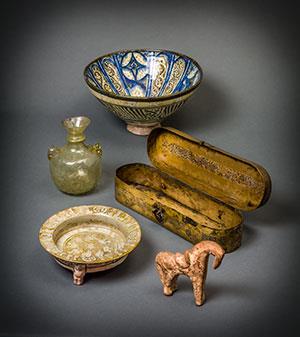UMMA to Exhibit 11 Centuries of Islamic Art in 'Fragments from the Past'

A collaborative effort. UMMA will host the exhibition of objects from the Kelsey Museum of Architecture in its glass-walled Stenn Gallery. This exhibition is part of the UM Collections Collaborations series, supported by the Andrew W. Mellon foundation, where the UMMA showcases the diversity of the University’s art collections.
“It’s an opportunity to do something together,” said the associate director of the Kelsey museum, Dawn Johnson.
The breadth of this exhibition is impressive: It spans eleven centuries, five countries and will include all types of objects, from bowls to figurines. However, this exhibit seeks to give a broader overview of Islamic art than other temporary exhibitions might.
“It’s really just to give a taste of some of the collections we have, and yes, it is broad,” Johnson said.
Think of this exhibition an introductory course in Islamic art that prepares you for more advanced classes. In January, there will be a showcase of art and architecture from the mansion, appropriately titled “Shangri-La: Architecture, Landscape, and Islamic Art,” of famed art collector Doris Duke.
Then, Christiane Gruber, associate professor of Islamic art, who recently organized a symposium on the art of the Arab Spring uprisings, will be curating a more in-depth exhibition of Islamic art next fall. As part of her exhibition, Professor Gruber will showcase pieces that cannot be shown in the transparent Stenn Gallery.
“It’s all glass, and it has very high light levels, so any of our wood objects, any of our textiles, the light levels are too high,” Johnson said. “So we could only show things that are metal, are glass, are ceramics.”
But with the only constraint being a material one, Johnson had a wide variety of pieces to pick from while curating the exhibit. She followed the interests of the family who originally brought the pieces to the University. According to Johnson, much of the collection was donated by former University president Alexander Grant Ruthven and collected by his son, Alexander Peter Ruthven. The latter Ruthven focused on the aesthetic — the big, beautiful objects that had very ornate details.
“That’s kind of how we chose some of our pieces, for their aesthetic quality, the beauty of the objects even though they were used for everyday use,” Johnson said.
The title of the exhibit — “Fragments from the Past” — is appropriate as many of the pieces are literally fragments of larger objects worn from use.
“There are a number of glass shards that have very intricate detail on them, but they still give clues to the cultural background of the pieces, the influence of culture,” Johnson said.
It isn’t that surprising that something like a glass bowl might be very intricate and detailed. But even objects used for more rigorous tasks were endowed with beauty by their creators.
“There are these beautiful ceramic filters, and there’s very ornate detail on them, but they were used to filter the Nile,” Johnson said. “The Nile is, and always has been, very dirty, so it’s a very functional piece, but you also see that the artisan gave amazing attention to that.”
The artisans of the Islamic world endowed the mundane objects of their daily lives with beauty. Now, “Fragments from the Past,” will take these objects and appreciate them for the art that they are and always have been.
At the very least, this exhibition will allow viewers to appreciate Islamic art as it exists beyond the mosques and mosaics. But after appreciating the beauty of a humble water filter, perhaps viewers will appreciate the beauty of the mundane objects of the present.
“It’s kind of this dialogue that’s happening from the past to the present in response, and I thinks that’s something that’s really important at the University,” Johnson said.
Source: Michigan Daily



